Queer Spaces: A world cruise through LGBTQ creative use of place
A new book edited by Adam Nathaniel Furman and Joshua Mardell, published by RIBA Publishing, takes the reader on a world cruise calling at 92 diverse locations where LGBTQ communities have created or adapted architectures to celebrate, socialise, organise, or simply exist.
The overlap of gay identity and history with art is so
ubiquitous it doesn’t really warrant discussion. That LGBTQ people have, and
always have, interest in making and consuming culture is less an observation
and more a cliché barely worth mentioning. The intersection of gayness and
architecture, however, is less expected or considered, and this new book edited
by Adam Nathaniel Furman and Joshua Mardell seeks to not only open a public
conversation about the overlap of LGBTQ identity with landscape and buildings,
but to do so with an exuberance, curiosity, and global outlook which seeks to
celebrate diversity rather than trap queerness into an identifiable form.
It is a genuine world cruise of architectures gays and non-conformers have createdor been forced to create and ventures not only into expected sites of pop-culture, dance and expression, but also realms less experienced by many (especially straight) readers - not least the various spaces of sexual encounter included, from nature and parks through to the final carriage of the Mexico subway and the toilets of Moscow’s Central V.I. Lenin Museum.
![]()
fig.i
The spaces included in this atlas also explore the multitude
identities, across individuals and cultures, of what it means to be gay within
a variety of periods and political systems. Sure, there is campness here,
alongside decadence and debauchery, but what is interesting amongst the selection
of 92 case studies –written by a diverse array of 55 contributors – is how
mundane and everyday many spaces are. What Furman and Mardell are
looking for in this publication is less how a space looks gay, queer, or camp, but how communities or individuals have existed, thrived, or struggled, and how they have created or adapted architectures to suit.
It enters the most public of spaces, but begins within the domestic with a selection of homes including Derek Jarman’s Prospect Cottage, his home purchased shortly after his HIV diagnosis which was a place of private sanctity, but also one for his friendships to flourish, a container of countless artworks, a site studied by his 16mm camera lens in film, the place of his life and eventual death, and now a site of pilgrimage and memory.
But a range of homo-homes are explored, from a working-class two-up two-down, to the houses in which Bangladeshi Hirja community live. All are spaces of culture alongside sexuality, but the home of Greek painter Yannis Tsarouchis. Andreas Angelidakis, who has designed the architecture for an exhibition of the artist, describes the theatricality of both Tsarouchis’ paintings and living space – both as it turns out works on canvas having covered the walls of his home in calico to create “a continuous theatrical painting stage, a salon fermé portal through which to transport his subjects into his signature lyrical reality.”
![]()
![]()
![]()
![]()
figs. ii-v
As could perhaps be expected, a number of featured spaces are those of music, dancing, display, and communal celebration. A range of nightclubs and performance spaces can be found through the pages of Queer Spaces. Angelidakis also takes us to Factory Nightclub in Athens, a former kebab shop which after graduation the author themselves turned into a silver, black, and fluorescent pink coloured club complete with sex dungeon, “a kind of grungy Studio 54 where every walk of life was manifest.”
In Bogotá we visit a former theatre which had found reuse as a porn cinema and then evangelical church before, with a few simple architectural cuts and openings, becoming Theatron, a nightclub hosting drag, DJs, and dancing. Since its opening in 2002 Theatron has proved so popular that more architectural cuts and openings have been needed – the theatre has been conjoined and extended into neighbouring buildings around the block to become a network of spaces covering 10,000m² and incorporating a restaurant, women’s clubs, and a sex shop.
In Makati City in the Philippines, the queer night Elephant Party is a space where performance art, fashion, and music come together. In San Juan, Puerto Rico, the collective-run El Hangar en Santurce hosts dance and art infused with decolonial politics, activism and eco-agricultural production. We read of Club Kali in 1990s London, a club night primarily for the South Asian community “with sarees and incense, dhol drummers, muscle-boys, glamorous Chutney Queens and an eclectic musical blend.”
In New York, the Palladium is revealed as a 1985 project from the promoters of Studio 54, and a former theatre transformed into decadent club where visual and video art conjoined with the lighting, sound as a Gesamtkunstwerk completed by the disco dancers themselves – largely comprising of queer black, Hispanic and Latinx communities all fighting oppression, racism and AIDS whilst releasing steam through dance.
Disco from New York travelled globally, evidence by New Sazae in Tokyo, secreted within a tiny space within a diversely multi-tenanted building attracting the legal and illegal outsiders of the urban construct. The venue was one of the first in the city to accept customers of all sexuality, gender and performativity, and in a city with many other dance venues, it retains the connection between disco and queerness.
![]()
![]()
![]()
figs.vi-viii
In Melbourne, we discover that a 1938 neoclassical façade conceals a nightclub space that has hosted David Bowie, Leigh Bowery, Lady Gaga and more within a radical 1985 design by Biltmoderne – rough-edged granite, crushed glass, contorted steel all making not only a post-industrial aesthetic, but queering materials to create roughage and energy rather than silence and sleek-withdrawal. We discover, however, that it is due to close as the building has been sold, its lease is expiring, the very culture and community which created value and prestige in a city district forced out by changed economies – the author Timothy Moore concluding that “it reinforces that the only permanent thing about a city, and its queer spaces, is its temporariness.”
Temporality is an urban condition sometimes desired by a community, or sometimes forced upon it. Queer Spaces also includes LGBTQ culture in Dhaka, Bangladesh, which centre on pop-up hangout events from dances, performance, plays, and readings in a variety of spaces including restaurants, cultural centres, or often in homes owned by a more affluent supporter or a diplomatic club with the help of a foreign-national. This is despite a danger to being a known queer organiser, and indeed the risk of being queer – and seen to be queer – in a conservative, suppressive society in which homosexuality is illegal.
![]()
![]()
![]()
figs.ix-xi
The book shows that queer spaces do not only occupy architecture – whether permanent or temporal – but also the streets of a city. The book presents Comparsa Drag in Buenos Aires, transgressively inhabiting public space as queer situationists – moving in flocks, ant-patriarchy urban stencilling, and participating in a trans pride event within a city slum compressed from all sids by upper-class wealth.
Nature and landscape architecture can also be turned into queer space, the book pulling focus on Caminito Verde in Mexico City, a public ark in Dhaka, and Aterro do Flamengo in Rio de Janeiro – each a space where planting offers concealment to sexual encounter. In Rio, the informal park running alongside Flemengo beach provides a variety of social functions, including shaded areas which offer spaces not only for gay cruising for sex, but also spaces of safety, social and sporting activity for queer society.
The park in Dhaka is one of only a few open public spaces in the city, a picturesque setting which at night becomes place of encounter for gay, bisexual and curious men. Queer Spaces offers testimony from a regular visitor recalling their first experience of such nocturnal exploration:
“I went back to where the action was, near the rows of Bokultola (Spanish cherry trees). There were more men gathering. I was even more anxious. I’d found a place to sit. Amongst me were other men, talking away, smoking. It felt like a gay space. A policeman approached me, asked if I was a regular; I’d nodded no. He went on to cuddle between two men, came back to me and said, ‘We’re all buddies here, don’t worry’ … I sat in disbelief and also wonderment, that this is possible here.”
Similarly, Caminito Verde is a space in which natural acts of both human and plant life take place. A landscape on the south of the city, formed of volcanic rock and overgrown vegetation and intermingling the territories between the modernist blocks of the main city university, it is a space of both seclusion and revealment. Authorities have on occasion cleared the site and prevented the its queer adoption, but nature only returns in all its forms, and as the book states: “the Caminito stands as a testimony to the creative and resilient quality of queer subjectivity, and the alliance it can forge with public urban natural areas.”
![]()
![]()
![]()
The book itself delves into countless more urban shadows to explore how queer people have adapted or created architectures to not only exist but flourish. Throughout the pages, it is noticeable how creativity and culture are not only tools of decorating or personalising such spaces, but fundamental to the very existence of the spaces and communities which develop. Art and culture as a way of being, for which architecture then becomes an extension of selves, saturates the case studies. Even in examples where the city simply appears as a backdrop to the acts – whether in its concrete and built-form or planted and natural form – it is shown not to be inert to the human activities, but often a co-producer, and in the case of cruising grounds seemingly growing up to allow queer acts to occur within.
Queer spaces are creative through the very act of being carved from a heteronormative and patriarchal world, one which not only permeates politics and culture, but which is imbued into every brick and paving slab of the built landscape, and presumed and planted into every area of public nature. The very nature of such subtle, creative carving into a normative system is that the notion of visibility can be considered and measured – and often not publicly visible, or at least not visible to eyes and minds which would not recognise codes or ways of reading the city.
It is also important to know that many queer spaces have to remain invisible, despite this celebratory book, because of various nations’ homophobia and politics, and in their introduction, Furman and Mardell emphasise this: “an important limiting factor was that in many parts of the world queer spaces, communities and individuals require secrecy for their continued safety, and could not yet participate in a publication of this nature.”
It is a genuine world cruise of architectures gays and non-conformers have createdor been forced to create and ventures not only into expected sites of pop-culture, dance and expression, but also realms less experienced by many (especially straight) readers - not least the various spaces of sexual encounter included, from nature and parks through to the final carriage of the Mexico subway and the toilets of Moscow’s Central V.I. Lenin Museum.
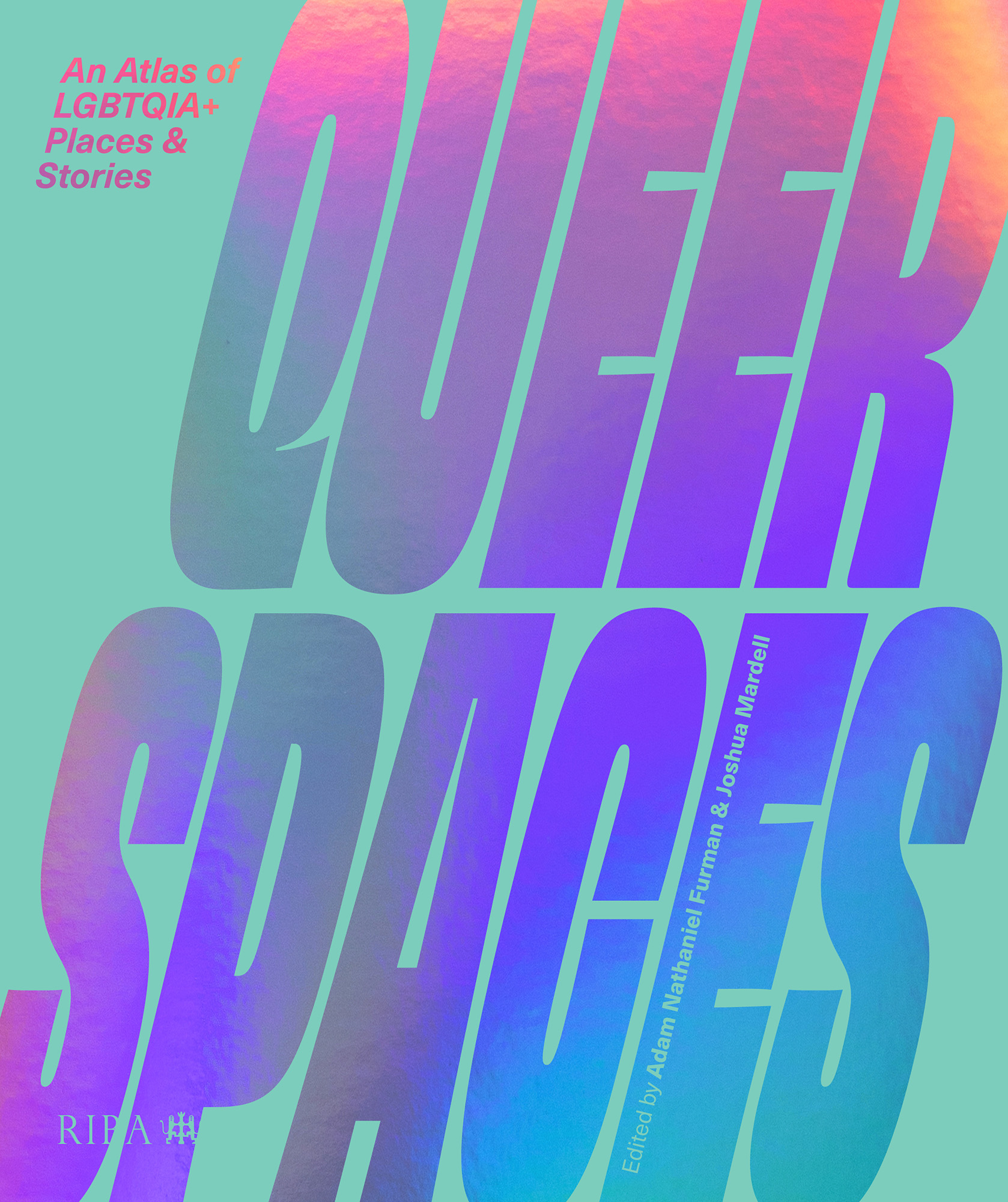
fig.i
It enters the most public of spaces, but begins within the domestic with a selection of homes including Derek Jarman’s Prospect Cottage, his home purchased shortly after his HIV diagnosis which was a place of private sanctity, but also one for his friendships to flourish, a container of countless artworks, a site studied by his 16mm camera lens in film, the place of his life and eventual death, and now a site of pilgrimage and memory.
But a range of homo-homes are explored, from a working-class two-up two-down, to the houses in which Bangladeshi Hirja community live. All are spaces of culture alongside sexuality, but the home of Greek painter Yannis Tsarouchis. Andreas Angelidakis, who has designed the architecture for an exhibition of the artist, describes the theatricality of both Tsarouchis’ paintings and living space – both as it turns out works on canvas having covered the walls of his home in calico to create “a continuous theatrical painting stage, a salon fermé portal through which to transport his subjects into his signature lyrical reality.”
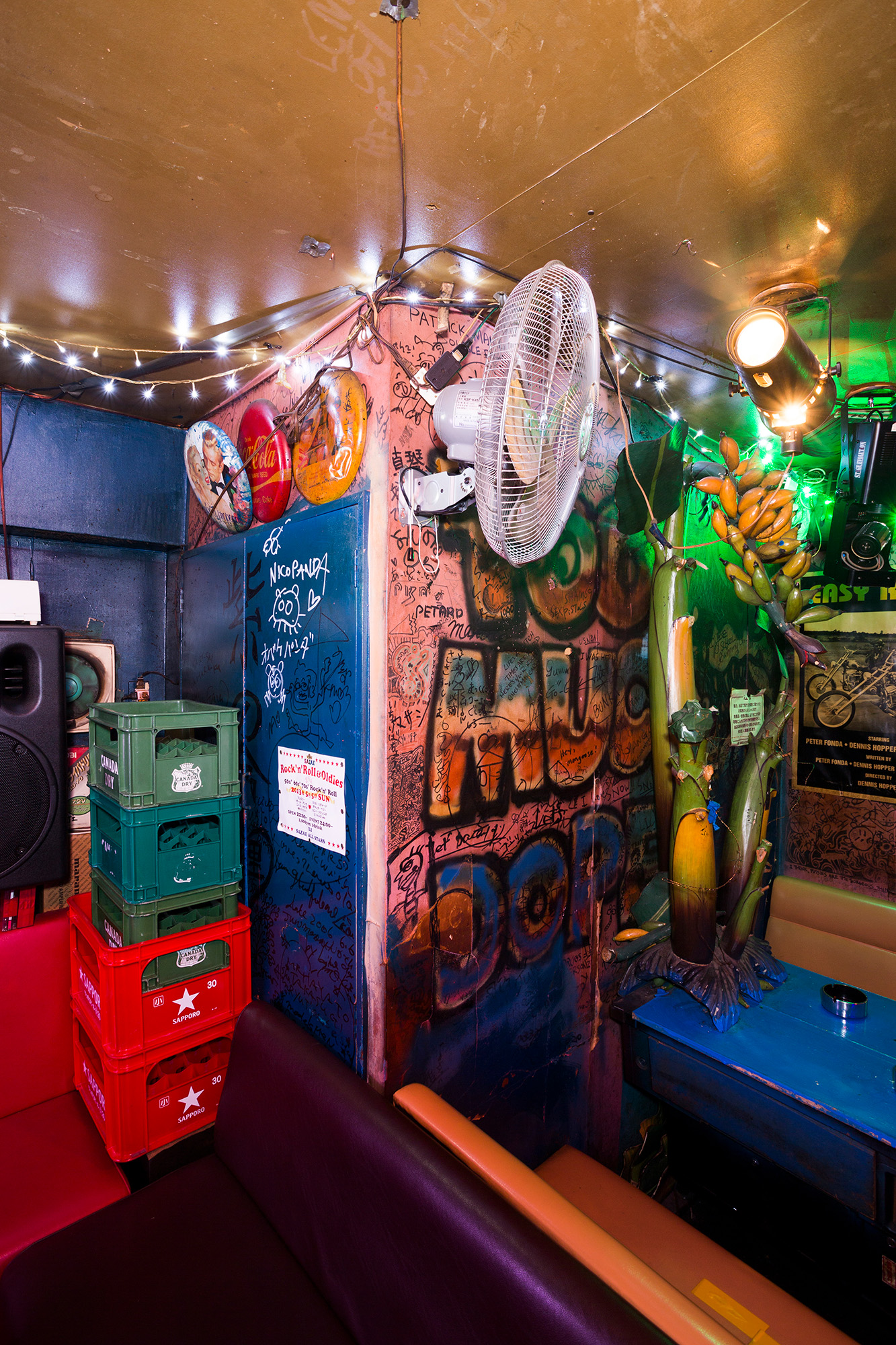



figs. ii-v
As could perhaps be expected, a number of featured spaces are those of music, dancing, display, and communal celebration. A range of nightclubs and performance spaces can be found through the pages of Queer Spaces. Angelidakis also takes us to Factory Nightclub in Athens, a former kebab shop which after graduation the author themselves turned into a silver, black, and fluorescent pink coloured club complete with sex dungeon, “a kind of grungy Studio 54 where every walk of life was manifest.”
In Bogotá we visit a former theatre which had found reuse as a porn cinema and then evangelical church before, with a few simple architectural cuts and openings, becoming Theatron, a nightclub hosting drag, DJs, and dancing. Since its opening in 2002 Theatron has proved so popular that more architectural cuts and openings have been needed – the theatre has been conjoined and extended into neighbouring buildings around the block to become a network of spaces covering 10,000m² and incorporating a restaurant, women’s clubs, and a sex shop.
In Makati City in the Philippines, the queer night Elephant Party is a space where performance art, fashion, and music come together. In San Juan, Puerto Rico, the collective-run El Hangar en Santurce hosts dance and art infused with decolonial politics, activism and eco-agricultural production. We read of Club Kali in 1990s London, a club night primarily for the South Asian community “with sarees and incense, dhol drummers, muscle-boys, glamorous Chutney Queens and an eclectic musical blend.”
In New York, the Palladium is revealed as a 1985 project from the promoters of Studio 54, and a former theatre transformed into decadent club where visual and video art conjoined with the lighting, sound as a Gesamtkunstwerk completed by the disco dancers themselves – largely comprising of queer black, Hispanic and Latinx communities all fighting oppression, racism and AIDS whilst releasing steam through dance.
Disco from New York travelled globally, evidence by New Sazae in Tokyo, secreted within a tiny space within a diversely multi-tenanted building attracting the legal and illegal outsiders of the urban construct. The venue was one of the first in the city to accept customers of all sexuality, gender and performativity, and in a city with many other dance venues, it retains the connection between disco and queerness.

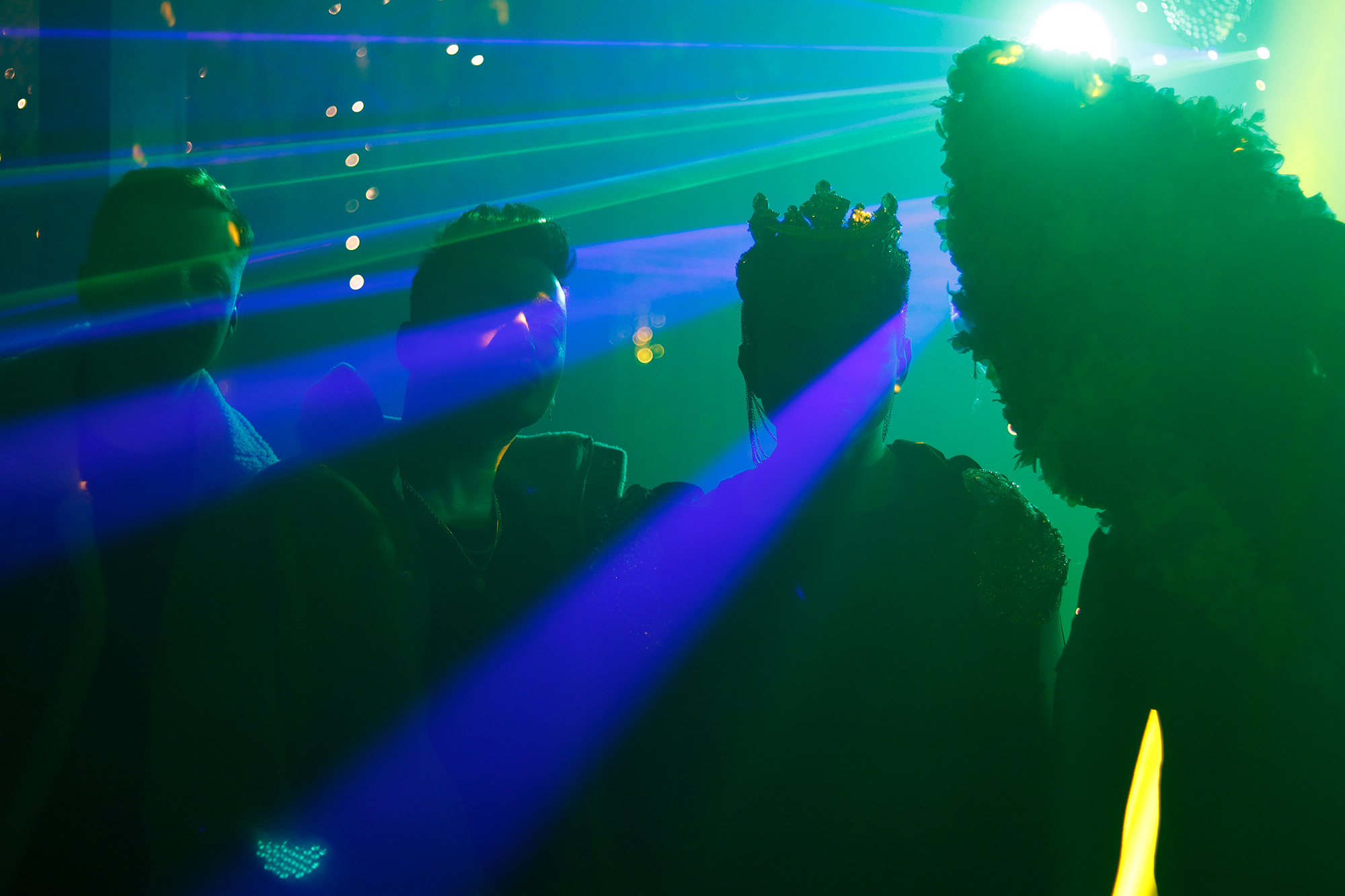

figs.vi-viii
In Melbourne, we discover that a 1938 neoclassical façade conceals a nightclub space that has hosted David Bowie, Leigh Bowery, Lady Gaga and more within a radical 1985 design by Biltmoderne – rough-edged granite, crushed glass, contorted steel all making not only a post-industrial aesthetic, but queering materials to create roughage and energy rather than silence and sleek-withdrawal. We discover, however, that it is due to close as the building has been sold, its lease is expiring, the very culture and community which created value and prestige in a city district forced out by changed economies – the author Timothy Moore concluding that “it reinforces that the only permanent thing about a city, and its queer spaces, is its temporariness.”
Temporality is an urban condition sometimes desired by a community, or sometimes forced upon it. Queer Spaces also includes LGBTQ culture in Dhaka, Bangladesh, which centre on pop-up hangout events from dances, performance, plays, and readings in a variety of spaces including restaurants, cultural centres, or often in homes owned by a more affluent supporter or a diplomatic club with the help of a foreign-national. This is despite a danger to being a known queer organiser, and indeed the risk of being queer – and seen to be queer – in a conservative, suppressive society in which homosexuality is illegal.
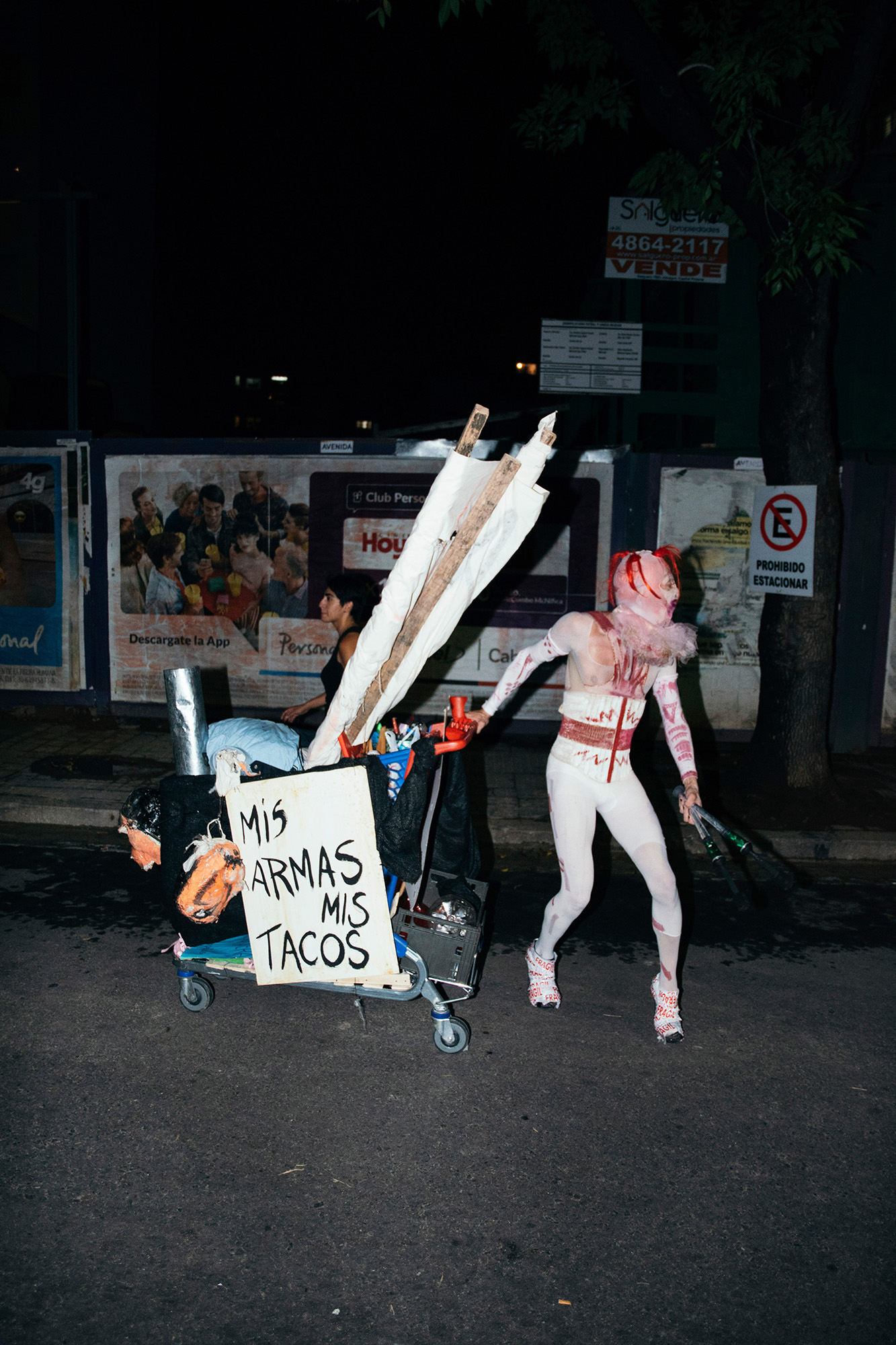

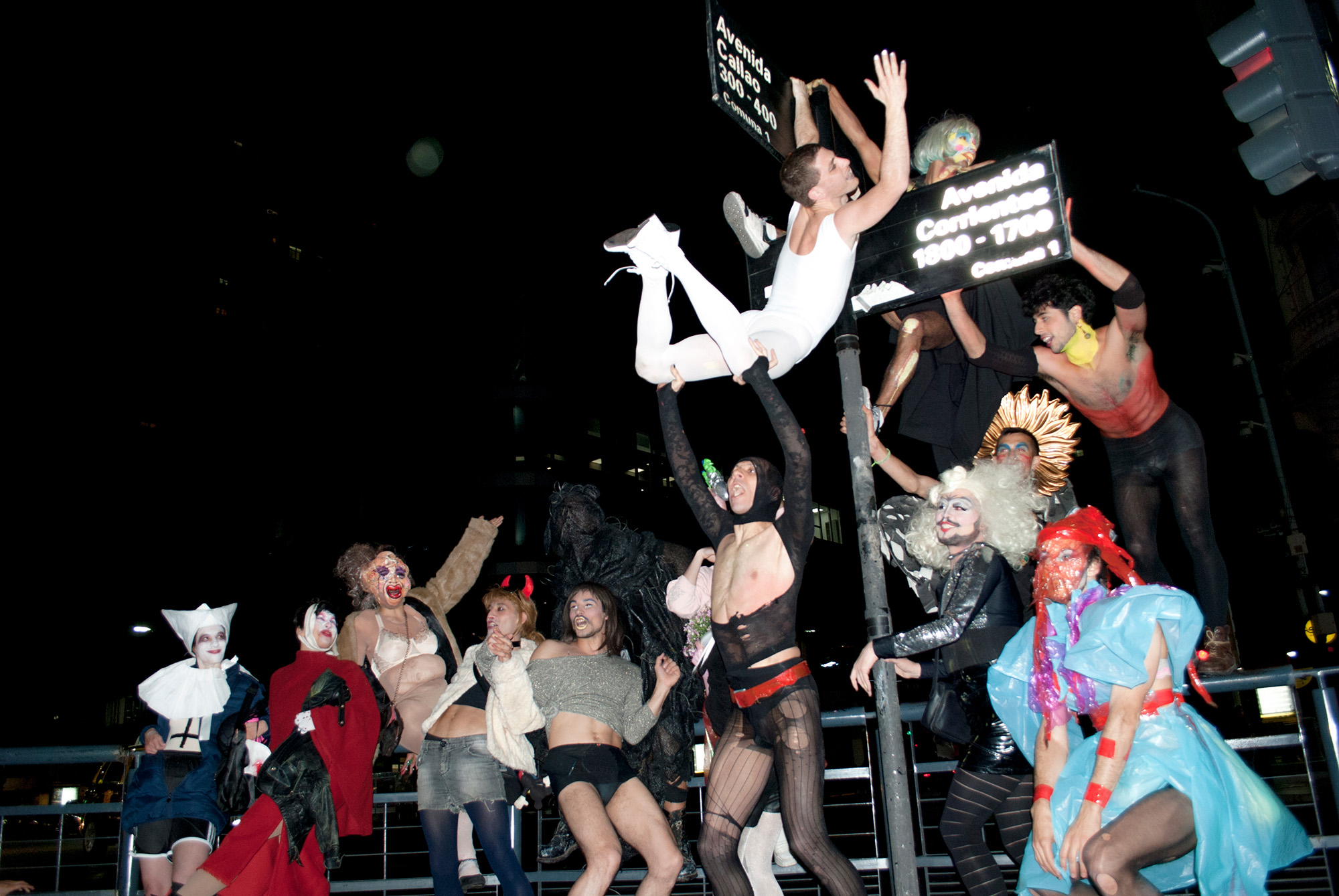
figs.ix-xi
The book shows that queer spaces do not only occupy architecture – whether permanent or temporal – but also the streets of a city. The book presents Comparsa Drag in Buenos Aires, transgressively inhabiting public space as queer situationists – moving in flocks, ant-patriarchy urban stencilling, and participating in a trans pride event within a city slum compressed from all sids by upper-class wealth.
Nature and landscape architecture can also be turned into queer space, the book pulling focus on Caminito Verde in Mexico City, a public ark in Dhaka, and Aterro do Flamengo in Rio de Janeiro – each a space where planting offers concealment to sexual encounter. In Rio, the informal park running alongside Flemengo beach provides a variety of social functions, including shaded areas which offer spaces not only for gay cruising for sex, but also spaces of safety, social and sporting activity for queer society.
The park in Dhaka is one of only a few open public spaces in the city, a picturesque setting which at night becomes place of encounter for gay, bisexual and curious men. Queer Spaces offers testimony from a regular visitor recalling their first experience of such nocturnal exploration:
“I went back to where the action was, near the rows of Bokultola (Spanish cherry trees). There were more men gathering. I was even more anxious. I’d found a place to sit. Amongst me were other men, talking away, smoking. It felt like a gay space. A policeman approached me, asked if I was a regular; I’d nodded no. He went on to cuddle between two men, came back to me and said, ‘We’re all buddies here, don’t worry’ … I sat in disbelief and also wonderment, that this is possible here.”
Similarly, Caminito Verde is a space in which natural acts of both human and plant life take place. A landscape on the south of the city, formed of volcanic rock and overgrown vegetation and intermingling the territories between the modernist blocks of the main city university, it is a space of both seclusion and revealment. Authorities have on occasion cleared the site and prevented the its queer adoption, but nature only returns in all its forms, and as the book states: “the Caminito stands as a testimony to the creative and resilient quality of queer subjectivity, and the alliance it can forge with public urban natural areas.”


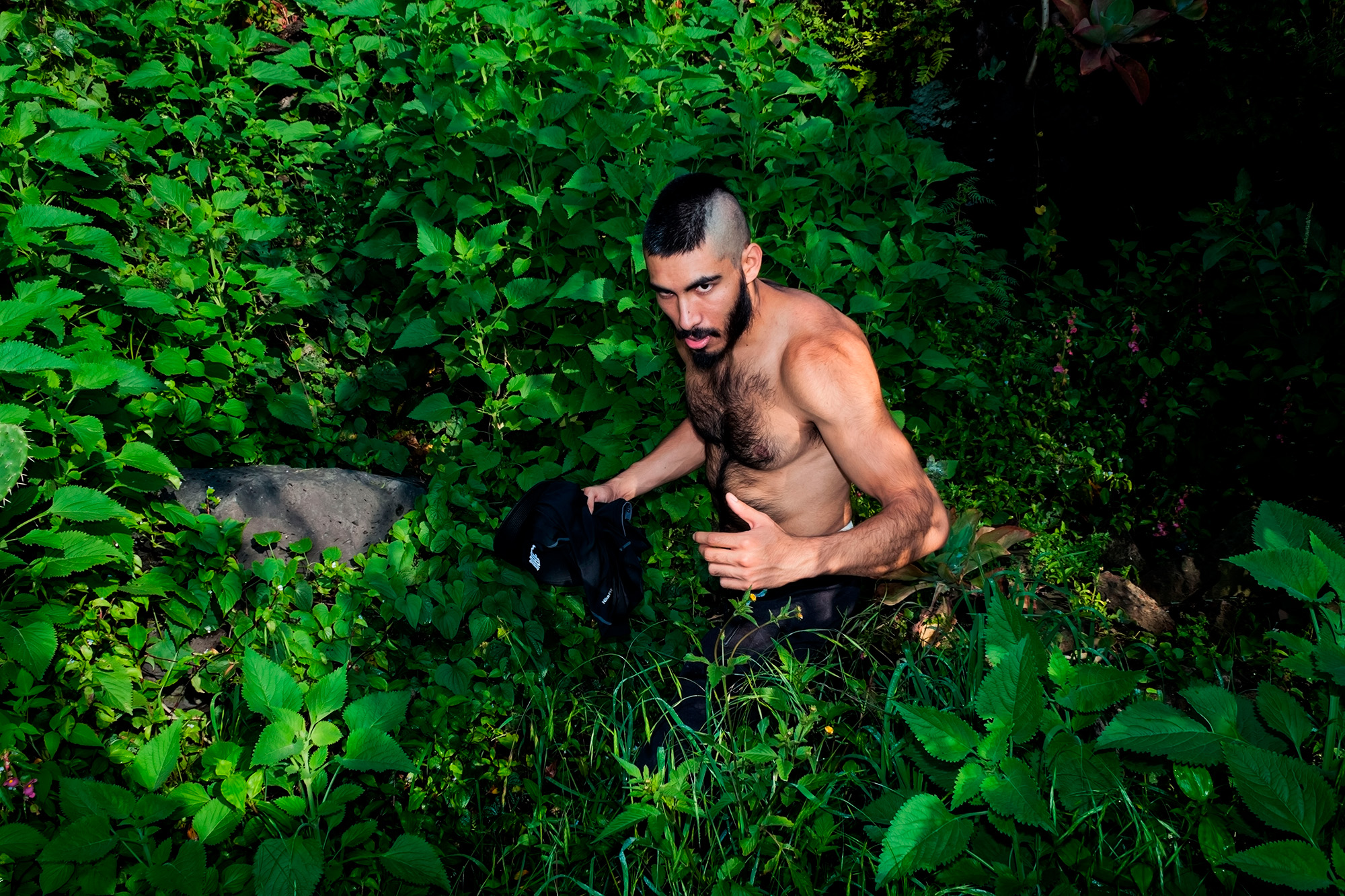
figs.xii-xiv
The book itself delves into countless more urban shadows to explore how queer people have adapted or created architectures to not only exist but flourish. Throughout the pages, it is noticeable how creativity and culture are not only tools of decorating or personalising such spaces, but fundamental to the very existence of the spaces and communities which develop. Art and culture as a way of being, for which architecture then becomes an extension of selves, saturates the case studies. Even in examples where the city simply appears as a backdrop to the acts – whether in its concrete and built-form or planted and natural form – it is shown not to be inert to the human activities, but often a co-producer, and in the case of cruising grounds seemingly growing up to allow queer acts to occur within.
Queer spaces are creative through the very act of being carved from a heteronormative and patriarchal world, one which not only permeates politics and culture, but which is imbued into every brick and paving slab of the built landscape, and presumed and planted into every area of public nature. The very nature of such subtle, creative carving into a normative system is that the notion of visibility can be considered and measured – and often not publicly visible, or at least not visible to eyes and minds which would not recognise codes or ways of reading the city.
It is also important to know that many queer spaces have to remain invisible, despite this celebratory book, because of various nations’ homophobia and politics, and in their introduction, Furman and Mardell emphasise this: “an important limiting factor was that in many parts of the world queer spaces, communities and individuals require secrecy for their continued safety, and could not yet participate in a publication of this nature.”
Adam Nathaniel Furman is an artist and designer who trained in architecture, and who works in spatial design and art of all scales, from videos and prints to large-scale public artworks, architecture, architecturally integrated ornament, as well as products, furniture, interiors, publishing and academia.
www.adamnathanielfurman.com
Joshua Mardell is an architectural historian, and is currently an Associate Lecturer in the Department of History of Art at the University of York and Research Collections Fellow at the Paul Mellon Centre for Studies in British Art.
purchase
Queer Spaces: An Atlas of LGBTQIA+ Places and Stories, edited by Adam Nathaniel Furman and Joshua Mardell, is published by RIBA Publishing. It is available from all good bookshops and from the RIBA bookshop:
www.ribabooks.com/queer-spaces-an-atlas-of-lgbtqia-places-and-stories_9781914124211
images
fig.i Queer Spaces cover, designed by Alex Synge / The First 47.
figs.ii-v New Sazae, Tokyo, photographs
©
Kaoru Yamada, originally featured in ROADSIDERS’ WEEKLY.
fig.vi Pop-up queer spaces in Dhaka, photographs
© Ruhul Abdin and Tarannum Nibir.
figs.vii-viii Pop-up queer spaces in Dhaka, photographs
© Ruhul Abdin and Maruf Arefin Mim.
fig.ix Comparsa Drag event, photograph © Vicente Vila.
fig.x
Comparsa Drag event, photograph © Julian Cardoso.
fig.xi
Comparsa Drag event, photograph © Dagurke.
figs.xii-xiv Caminito Verde, Mexico, photographs © Eusebio Penha.
publication date
14 December 2022
tags
AIDs, Andreas Angelidakis, Athens, Bangladesh, Biltmoderne, Bogotá, Buenos Aires, Community, Cruising, Dancing, Dhaka, Disco, Adam Nathaniel Furman, Gay, Homophobia, Homosexuality, Derek Jarman, LGBTQ, London, Joshua Mardell, Makati City, Melbourne, Mexico City, Timothy Moore, Nature, New York, RIBA, Rio de Janeiro, San Juan, Sex, Sexuality, Temporality, Tokyo, Transexual, Yannis Tsarouchis, Queer
www.ribabooks.com/queer-spaces-an-atlas-of-lgbtqia-places-and-stories_9781914124211


